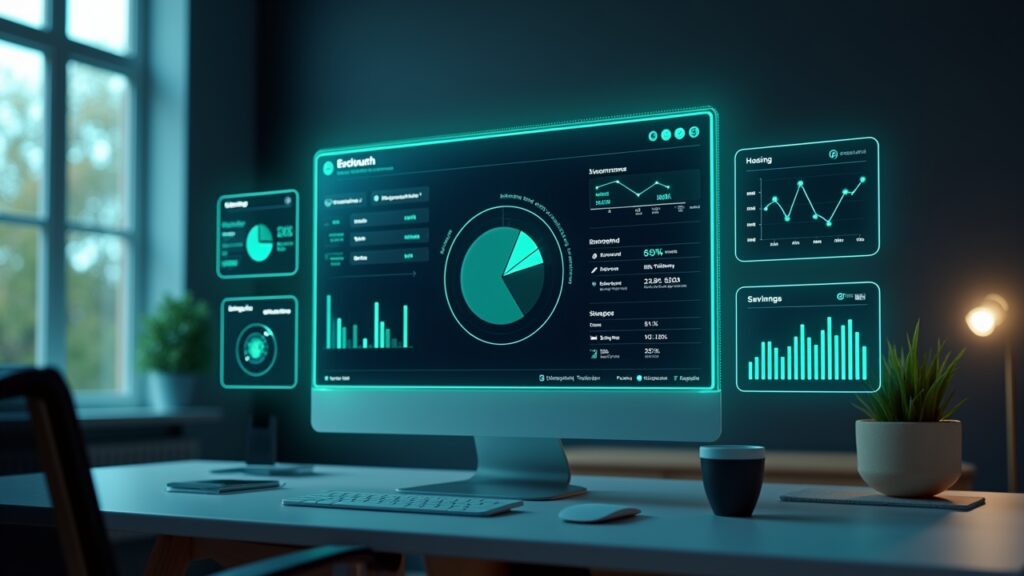Advertisements
Did you know that 65% of Americans don’t know how much they spent last month? I used to be one of them until my wife found a receipt for a $200 “emergency” gaming headset hidden in my car. That awkward dinner conversation led me down the rabbit hole of automatic budgeting, and honestly, it’s been a game-changer!
Let me tell you, managing money manually is like trying to herd cats while blindfolded. I’d tried everything – spreadsheets that I’d update for exactly three days, envelopes stuffed with cash that somehow always ended up empty, and even those fancy budget journals that are supposed to make you feel productive. Nothing stuck until I discovered the magic of letting technology do the heavy lifting.
What Exactly Is Automatic Budgeting?

So here’s the deal – automatic budgeting is basically having a digital assistant that tracks every penny without you lifting a finger. These smart budgeting apps connect to your bank accounts and credit cards, then automatically categorize your spending. It’s like having a really organized friend who’s obsessed with your finances (but in a good way).
The first time I set up Mint, I was shocked. Apparently, I was spending $347 a month on “coffee and snacks.” My wife wasn’t surprised, but I sure was! The app showed me exactly where my money was disappearing to, and trust me, ignorance is not bliss when it comes to your bank account.
The Real Benefits That Nobody Talks About
Sure, everyone mentions saving money and tracking expenses, but let me share what actually matters. First off, automatic budgeting eliminated 90% of our money fights. When the app sends us both notifications about overspending, there’s no more “I thought you were tracking that!” arguments.
Another huge win? I actually sleep better now. Sounds cheesy, but knowing exactly where I stand financially means no more 3 AM panic attacks wondering if I can afford the mortgage payment. The peace of mind alone is worth the hassle of setting everything up.
Oh, and here’s something wild – automatic categorization helped me realize I was getting double-charged for my gym membership for six months! That’s $240 I got back because the app flagged duplicate transactions. Would I have caught that on my own? Probably not.
Setting Up Your First Automated Budget System
Alright, let’s get into the nitty-gritty. Setting up budget automation isn’t rocket science, but there’s definitely a right way to do it. Start by choosing your weapon – I mean app. YNAB (You Need A Budget) is fantastic if you want to get really hands-on, while Mint is better for the “set it and forget it” crowd.
Here’s my step-by-step process that actually works:
- Link all your accounts (yes, even that secret PayPal you use for online shopping)
- Let the app run for a full month without changing anything – you need baseline data
- Review and fix any miscategorized transactions (no, Taco Bell isn’t “groceries”)
- Set realistic spending limits based on your actual habits, not fantasy numbers
- Turn on alerts for when you’re close to limits
Pro tip: Don’t try to be perfect right away. I made the mistake of setting super aggressive budgets initially, failed miserably, and almost gave up. Start where you are, then gradually tighten things up.
Common Pitfalls and How to Dodge Them
Look, I’ve messed up plenty with automated budgeting, so learn from my mistakes. The biggest one? Forgetting about annual expenses. My car registration nearly killed my budget because I hadn’t accounted for it. Now I divide annual costs by 12 and save automatically each month.
Another gotcha is cash spending. These apps can’t track cash unless you manually add it, which defeats the whole “automatic” purpose. My solution? I barely use cash anymore, and when I do, I immediately log it in the app while I’m still at the register. Takes 10 seconds and saves future headaches.
Security worries kept me from starting for years. But here’s the thing – these apps use bank-level encryption and read-only access. They can see your transactions but can’t move money. Still nervous? Start with just one account and see how it goes.
Making Automatic Budgeting Work for Your Life
The secret sauce is customization. Generic budget categories don’t work for everyone – I had to create a separate category for “wife’s plant addiction” because apparently “miscellaneous” wasn’t specific enough! The more your budget reflects your actual life, the more likely you’ll stick with it.
Set up different rules for different accounts too. My checking account sends alerts for anything over $50, but my bills account only notifies me if something seems off. This way, I’m not drowning in notifications but still catch important stuff.
Weekly check-ins are crucial, even with automation. Every Sunday morning, coffee in hand, I spend 15 minutes reviewing the week. It’s become a weird ritual I actually enjoy. Sometimes I’ll spot a subscription I forgot to cancel or notice we’re trending high on dining out, giving me time to course-correct.
Your Financial Freedom Starts Now

After two years of automatic budgeting, I can honestly say it’s transformed how I think about money. We’ve paid off $8,000 in credit card debt, saved for a real vacation (not just a weekend trip to my in-laws), and I no longer break into a cold sweat when bills arrive.
The best part? Once it’s set up, it runs itself. You’re not chained to a spreadsheet or frantically calculating if you can afford that dinner out. The app tells you straight up – yes or no. It’s liberating, really.
Ready to take control of your finances without the constant stress? Pick an app today – seriously, right now while you’re motivated. Future you will thank present you, trust me on this one. And if you’re looking for more practical money tips that actually work in real life, check out other posts on Cashflow Zen. We’re all about making finances less painful and more, well, zen!




[…] to level up your money game even more? Head over to Cashflow Zen for more practical tips on mastering your finances. Trust me, your wallet will thank […]